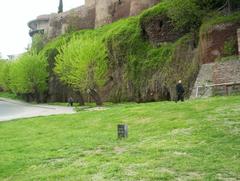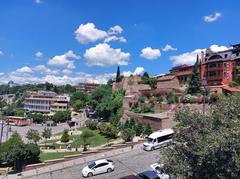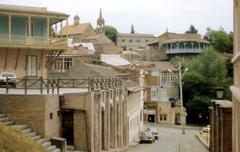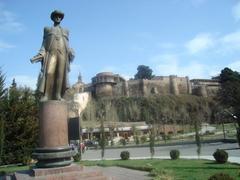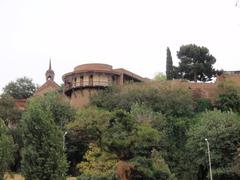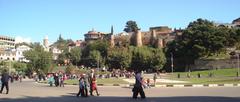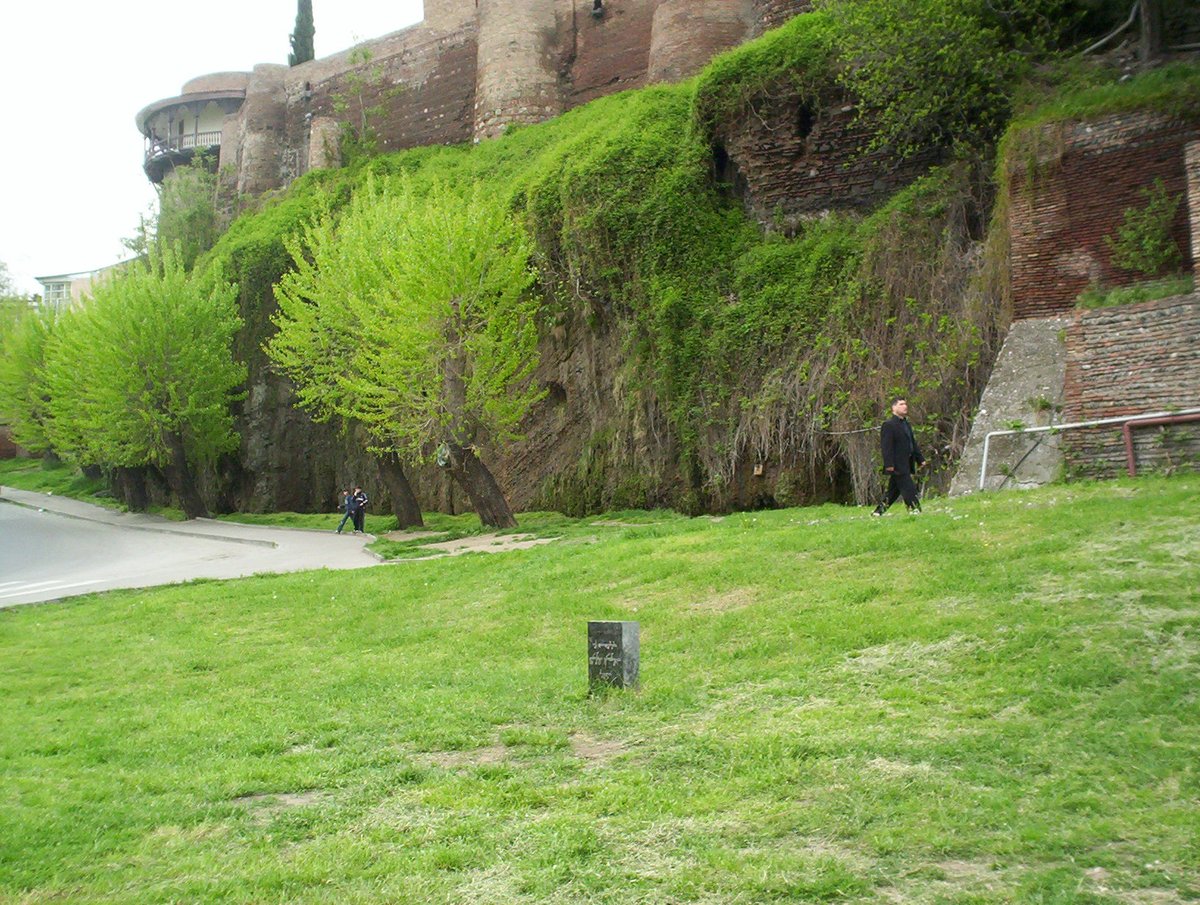
Queen Darejan’s Palace: Visiting Hours, Tickets, and Historical Sites in Tbilisi, Georgia
Date: 14/06/2025
Introduction
Queen Darejan’s Palace, also known as Sachino, is a distinguished historical landmark in Tbilisi’s Avlabari district. Built in 1776 for Queen Darejan Dadiani, the palace offers a vivid window into Georgia’s 18th-century royal heritage, architectural synthesis, and cultural resilience. Perched on a cliff above the Mtkvari (Kura) River, it has served as a royal residence, religious institution, and a center for charitable and cultural activities over centuries. This guide provides comprehensive information on visiting hours, tickets, accessibility, nearby attractions, and essential historical and architectural highlights to enrich your visit.
For further details, see authoritative resources such as the Eurasia Travel guide, the Georgian Journal’s feature on Sachino Palace, and the Official Georgian Tourism website.
Table of Contents
- Introduction
- Historical Overview
- Architectural Highlights
- Visiting Information
- Accessibility and Travel Tips
- Nearby Attractions
- Restoration and Preservation
- Unique Features and Recommendations
- Frequently Asked Questions (FAQ)
- Conclusion
- Sources
Historical Overview
Origins and Construction
Queen Darejan’s Palace was commissioned by King Heraclius II for his third wife, Queen Darejan, in 1776. The palace symbolizes royal authority and is an outstanding example of the cultural crossroads that shaped Tbilisi, blending Georgian, Persian, and European architectural elements (eurasia.travel). The fortified structure, built from square bricks and cobblestones, reflects the region’s turbulent late-18th-century history.
Royal Residents and Political Context
Queen Darejan, a member of the influential Dadiani family, played a prominent role in the royal court, while King Heraclius II was known for his leadership in a period marked by regional upheaval. The palace witnessed significant historical events, including Persian invasions and subsequent political shifts (eurasia.travel).
Transformation and Modern Era
After Queen Darejan’s departure in 1807, the palace was repurposed as a theological seminary, and later as the Transfiguration Monastery. Throughout the 19th and 20th centuries, it served as a parish school, warehouse, museum, theater, and, since 1991, as the Transfiguration Convent, continuing its religious and charitable mission.
Architectural Highlights
Exterior Features
- Layout and Structure: The palace is primarily a rectangular structure with interconnected buildings, including residential quarters, service areas, and a chapel. Its thick walls provide insulation and security (Tbilisi City Hall).
- Façades and Ornamentation: Arched windows and horseshoe-shaped arches on the eastern façade reflect Persian influences, while decorative brickwork and stucco ornamentation add elegance.
- Terraces: Multi-level terraces offer panoramic views of Old Tbilisi, Narikala Fortress, and the Mtkvari River.
Interior Features
- Grand Hall: The central hall, with high ceilings and large windows, was used for royal receptions and gatherings.
- Decorative Elements: Fragments of painted plasterwork and restored wooden ceilings display intricate floral and geometric patterns typical of late-18th-century Georgian and Persian art (National Agency for Cultural Heritage Preservation of Georgia).
- Fireplaces and Flooring: Original ceramic tiles and elegant fireplaces highlight the blend of function and aesthetics.
Notable Highlights
- The Loggia: The eastern loggia, framed by arches and columns, connects indoor and outdoor spaces and serves as a symbol of the palace’s openness.
- The Chapel: A small domed chapel attached to the palace, with fresco remnants, underlines its spiritual role (Tbilisi Guide).
- Turquoise Balcony: The round, intricately carved turquoise balcony is a signature feature and a favorite photography spot (onlybyland.com).
Visiting Information
Location and Getting There
- Address: 7 Urbnisi Street, Avlabari, Tbilisi
- By Metro: Avlabari Metro Station is a 5–10 minute walk.
- By Bus: Bus 337 from Freedom Square arrives in about 12 minutes.
- On Foot: Walk from Freedom Square via the Metekhi Bridge or through Rike Park for a scenic approach.
- By Taxi: Taxis are inexpensive and widely available.
Visiting Hours and Tickets
- Hours: Open daily from 10:00 AM to 2:00 PM. Strictly observed; check for seasonal or holiday variations (madloba.info).
- Admission: Free of charge; donations encouraged to support preservation.
- Dress Code: Modest attire is required (shoulders and knees covered), as the site is an active convent (onlybyland.com).
Facilities
- Onsite Facilities: Limited; includes monastery, charity house, hospice, and craft workshops (georgianholidays.com).
- Restrooms and Cafes: Basic amenities available; more options nearby in Old Tbilisi.
Accessibility and Travel Tips
- Mobility: The palace is accessed via a moderate uphill walk and stairs; may be challenging for those with mobility issues.
- Best Time to Visit: Early mornings for tranquility and optimal photography conditions.
- Nearby Attractions: Rike Park, Peace Bridge, Narikala Fortress, and Metekhi Church are all within a 15–20 minute walk (dolidoki.com).
- Etiquette: Maintain quiet and seek permission before photographing nuns or ceremonies.
Restoration and Preservation
Major restoration efforts between 2019 and 2024, led by Tbilisi City Hall, have stabilized the structure and revived 18th-century wall paintings (georgia.travel). The palace now functions as a convent and charity center, maintaining its historical role as a community hub.
Unique Features and Recommendations
- Tranquility: Less crowded than other Tbilisi sites, ideal for reflection and photography (madloba.info).
- Photographic Opportunities: The turquoise balcony at sunset or after dark is especially striking.
- Cultural Engagement: Craft workshops and the charity house allow visitors to experience living Georgian traditions.
- Guided Tours: Offered by local agencies or via self-guided walking tour apps (gpsmycity.com).
Frequently Asked Questions (FAQ)
Q: What are the visiting hours?
A: Daily from 10:00 AM to 2:00 PM.
Q: Is there an admission fee?
A: No, entry is free; donations are welcome.
Q: Are guided tours available?
A: Yes, through local agencies and self-guided apps.
Q: Is the palace accessible for those with limited mobility?
A: Access involves stairs and a hill; may be challenging for some visitors.
Q: What is the dress code?
A: Modest dress (shoulders and knees covered) is required.
Q: When is the best time to visit for photography?
A: Early morning or sunset.
Nearby Attractions
- Rike Park: A modern riverside park with contemporary art and gardens.
- Narikala Fortress: A historic citadel with panoramic views.
- Metekhi Church: An iconic church overlooking the river.
- Bridge of Peace: A modern glass bridge connecting Old Tbilisi.
Conclusion
Queen Darejan’s Palace is a must-visit site for travelers seeking to understand Tbilisi’s unique blend of royal, religious, and communal heritage. Its serene setting, architectural beauty, and living traditions make it an essential stop beyond the city’s busier landmarks. Prepare for your visit by checking hours, dressing respectfully, and exploring the nearby historic core for a truly immersive Georgian experience.
For updates on events, restoration, and travel tips, download the Audiala app and follow official tourism channels.
Sources
- Queen Darejan’s Palace in Tbilisi: Visiting Hours, Tickets, and Historical Insights, Eurasia Travel
- Queen Darejan’s Palace in Tbilisi: Visiting Hours, Tickets, and Architectural Highlights, Georgian Journal
- Queen Darejan’s Palace Visiting Hours & Tbilisi Historical Sites: Salt in Our Hair
- Next Level of Travel: Tbilisi Itinerary
- Madloba Info: Queen Darejan Palace
- Georgian Holidays: Sachino Palace
- Dolidoki: Darejan Palace
- Georgia Travel: Queen Darejan Palace
- Only By Land: Tbilisi Attractions
- Georgian Travel Guide: Queen Darejan’s Palace
- Expats.land: Palace of Queen Darejan
- GPSMyCity: Queen Darejan’s Palace
- Tbilisi Guide: Queen Darejan’s Palace
- National Agency for Cultural Heritage Preservation of Georgia: Queen Darejan Palace
- Tbilisi City Hall: News on Restoration
